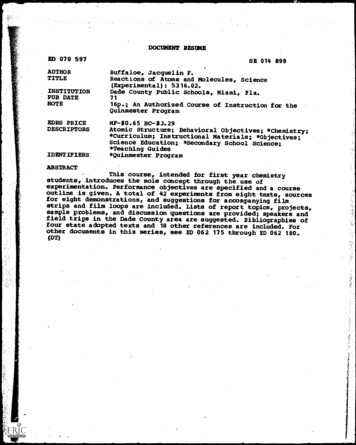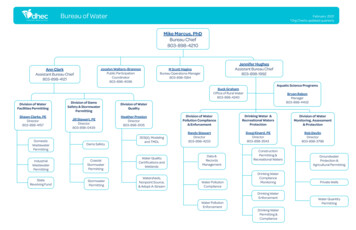
Transcription
DOCUMENT RESUMEED 070 597AUTHORTITLEINSTITUTIONPUB DATENOTEEDRS PRICEDESCRIPTORSIDENTIFIERSSE 014 898Buffaloe, Jacquelin F.Reactions of Atoms and Molecules, Science(Experimental): 5316.02.Dade County Public Schools, Miami, Fla.7116p.; An Authorized Course of Instruction for theQuinmester ProgramMF- 0.65 HC - 3.29Atomic Structure; Behavioral Objectives; *Chemistry;*Curriculum; Instructional Materials; *Objectives;Science Education; *Secondary School Science;*Teaching Guides*Quinmester ProgramABSTRACTThis course, intended for first year chemistrystudents, introduces the mole concept through the use ofexperimentation. Performance objectives are specified and a courseoutline is given. A total of 42 experiments from eight texts, sourcesfor eight demonstrations, and suggestions for accompanying filmstrips and film loops are included. Lists of report topics, projects,sample problems, and discussion questions are provided; speakers andfield trips in ;be Dade County area are suggested. Bibliographies offour state adopted texts and.18 other references are included. Forother documents in this series, see ED 062 175 through ED 062 180.(DT).4
U.S. DEPARTMENT OF HEALTH.EDUCATION & WELFAREOFFICE OF EDUCATIONTHIS DOCUMENT HAS SEEN REPRODUCED EXACTLY AS RECEIVED FROMTHE PERSON OR ORGANIZATION ORIGINATING 11 POINTS OF VIEW OR OPINIONS STATED DO NOT NECESSARILYREPRESENT OFFICIAL OFFICE OF EDUS.CATION POSITION OR POLICYt.AUTHORIZED COURSE OF INSTRUCTION FOR THEREACTIONS OF ATOMS AND 7cnC74:2ca*DIVISION OF INSTRUCTION1971
REACTION OF ATOMS AND NOLECULIE5316.02SCIENCE(Experimental)Written by: Chemistry Advisory CommitteeFirst Revision by Jacquelin F. Buffs loeDIVISION OF INSTRUCTIONDade County Public SchoolsMiami, Fla.19712
DADE COUNTY SCHOOL BOARDMr. William Lehman, ChairmanMr. G. Holmes Braddock, Vice-ChairmanMrs. Ethel BeckhamMrs. Crutcher HarrisonMrs. Anna Brenner MeyersDr. Ben SheppardMr. William H. TurnerDr. E. L. Whigham, Superintendent of SchoolsDade County Public SchoolsMiami, Florida 33132Published by the Dade County School BoardCopies of this publication may be obtained throughTextbook Services2210 S. W. Third StreetMiami, Florida 33135
TABLE OF CONTENTSPageCourse Description1Enrollment Guidelines1State Adopted Texts1Performance Objectives2Course Outline3EXperiments4Demonstrations6Films6Film Strips7Film Loops7Reports7Projects8Problems8Discussion Questions9Speakers and Field Trips10References'11Master Sheet12
REACTICtiS OF ATOMS AND MOLECULESCOURSE DESCRIPTION:Reactions of Atoms and Molecules introduces the mole concept through theuse of experimentation.formation from these experiments will allowthe student to write formulas and balanced equations and to solve simplestoichiometric problems. The laboratory investigations should guide thestudents into a study of bonding and molecular structure. This courseis adaptable for all first year chemistry students who are successful inScientific Mathematics and Introduction to Chemistr.ENROLLMENT GUIDEL221:The course is intended far all first year chemistry students who havebeen successfUl in Introduction to Chemistry and Scientific Mathematicsor who show their readiness through an acceptable score on a suitabletest.STATE AWNED TEXTS(1.Choppin and Jaffee. Chemistry: Science of Matter, Energy andChange. Morristown, New Jersey: Silver Burdett Co., 19b5.2.Greenstone, Sutaan, and Bollingworth. Cone is in ChemistNew York: Harcourt Brace and World, 193.4.Metcalfe Williams, and Castka. Modern Chemistry. New York:Holt, Rinehart, and Winston, Inc., 1966.O'Connor, Davis, Heenisch, McNab, and McClellan. ChemistExperiments and Principles. Atlanta: Raytheon Educat onCompany,. 1968.1:
PERFORMANCE OBJECTIVES1.Given a periodic table and a formula the student will demonstratehis knowledge of the mole concept by calculating:(1)(2)(3)(4)thethethethegram atomic and gram molecular massesmass of one atom or moleculemass of a given number of molesnumber of moles when a mass is given2.Given an equation, the student will interpret its meaning in termsof atoms, molecules, moles, gas volume, and mass.3.Given the chemical names of the reactants and products in a chemicalreaction, the student will(1)(2)(3)write the formulas for the chemicalswrite the balanced equation using the inspection methoddemonstrate his knowledge of the mole concept by using therelationships in the equation to solve weight-weight,weight-gas volume, and gas volume-gas volume problems.4.Given a periodic table the student will predict the types of bonds(covalent or electrovalent) formed when atoms combine.5.Given a peilodic table, the student will predict the shape ofmolecules in which bonding involves a and kelectrons. (OMITFOR NURSING CHEMISTRY.)
COURSE OUTLINEI.II.III.IV.Mole ConceptA.Gram molecular and gram atomic massesB.Weight of one atom or moleculeC.Weight of mass of a given number of moles of atomsD.Number of moles when a mass and formula are given(Problems shoull be simple for Nursing Chemistry students)Writing, Balancing, and Using EquationsA.Writing formulas and naming compoundsB.Writing equationsC.Balancing equations using inspection methodD.Problems to solve: wt.-wt.; wt.-gas volume; gas volume-gas volume(Problems for Nursing Chemistry students should use simplearithmetic.)BondingA.Types of bondsB.Requirements for formation of bondsMolecular Structure (Omit for Nursing Chemistry)A.Basic types of structure (shape)B.Row to predict shape of molecules
EXPERIMENTSCastka, Metcalfe, and Williams. Exercisers andNew York: Holt, Rinehart, and Winston, 191.2.3.4.5.6.eriments in Chemistry.Exercises and Experiments in Chemistry (pp. 153-145)Mass Relations in a Chemical Change (pp. 147-148)Types of Chemical Reactions (pp. 149-152)Replacement of Hydrogen by a Metal (pp. 155-56)Molar Volume of a Gas (pp. 157-158)Molecular Weight of a Gas (pp: 159-160)Davis, MacNab, Haenisch, McClellan, O'Connor. LaboratoChemistry: Experiments and Principles. Atlanta:7.8.9.10.11.Manural forThe Masses of Equal Volumes of Gases (pp. 8-11)CopperSilver Nitrate Reaction (pp. 17-20)Conservation of Mass During Chemical Changc (pp. 21-25)The Reaction of Magnesium with Hydrochloric Acid (pp. 32-37)Formula of a Precipitate (pp. 46-49)Ellis and Toon. Laboratory Experiments for Foundations of Chemistry.Holt, Rinehart and Winston, 196ö.New York:12.13.14.15.16.Mole Concept (pp. 48-51)The Properties of Some Representative Elements (pp. 38-42)The Significance and Use of the Periodic Table (pp. 88-93)Chemical Bonding (pp. 94-97)Bonding Capacities of Atoms and Directional Character ofHybrid Bonds (pp. 98-101)Ferguson, Schmuckler, Siegel:man.Change. Morristown, New Jersey:17.18.19.Investigating Matter' Ent/ruledSilver Burdett Co., 1966.The Mole and the Molar Volume (pp. 53-56)Mole Ratio and the Chemical Reaction I (pp. 63-68)The Formula of a Compound (pp. 57-61)Gellner, Lauren. Experimental Chemistry and Workbook. New York:Amoco Publications, 1965.20.21.22.23.24.25.Determination of Atomic Weight Using Specific Heat Data(pp. 71-74)Determination of the Percentage of Water in a Hydrate (pp. 41-42)Electrical Conductivity of Solutions of Compounds (pp. 43-46)Electrolysis (pp.-131-134)Relative Weights of Gases (pp. 55-58)Stoichiometry and Chemical Change (pp. 59-64)Greenstone. Concepts in Chemistry - Laboratory Manual. Atlanta:Harcourt, Brace and World, 1966.26.Separating Oxygen From an Oxide (pp. 24-25)
27.28.29.Determining the Emperical Formula of a Compound (pp. 38-40)Determining the Molecular Weight of a Gas (pp. 41-43)Molecular Weight by the Vapor Density Method (pp. 44-45)Pimentel, George C. ed.Manual. San Francisco:Chemistry: an Experimental Science LaboratoryW. H. Freeman and Co., 1963.30.31.The Weights of Equal Volumes of Gases (pp. 14-18)The Behavior of Solid Copper Immersed in a Water Solutionof the Compound Silver Nitrate (pp. 19-21)32.33.Miss Relationships Accompanyiug Chemical Changes (pp. 22-26)A Quantitative Investigation of the Reaction of a Metalwith Hydrochloric Acid (pp. 26-30)An Investigation of the Reacting Volumes of Two Solutionsof Known Concentration (pp. 31-33)Reactions Between Ions in Aqueous Solution (pp 34-35)34.35.Smith, William T. Jr. Laboratory Manual for College Chemistry.Harper and Row, Publishers, 1966.36.37.38.39.40.41.42.Percentage Composition of a Compound: Relative AtomicWeights (pp. 17-20)Changes; Substances (pp. 25-28)Molecular Weight of Carbon Dioxide (pp. 55-60)Percentage Composition of Copper Oxide (pp. 65-68)Molar Gas Volume (pp. 69-72)Formula of a Hydrate (pp. 77-80)Combining Weight of a Metal (pp. 123-126)5New York:
DEMNSTRATIONSAlyea and Dutton.Tested Demonstrations in Ohemistrz,Esfton, Penn:Division of ChesicarlEa1311747GXserican Chemical Society, 1962.1.2.3.4.Determination of Equivalent and Atomic Weights (pp. 71-72)Determination of Atomic and Molecular Weights (pp. 72-74)Water - Synthesis, Couposition of Water (pp. 59-60)Law of Conservation of Mass (pc 54)Ellis and Toon. Laboratory Experiments for Foundations of Chemistrz.New York: Bolt, Rinehart and Winston, Inc1-9-Cre5.Electron Transitions in Atoms (pp. 8-83)Pergerson, Schmuckler, and Siegelman. AgomdapAgffillAterillyAgmbMorristown, New Jersey: Silver Burdett Co., 19and Change.6.Mole Ratios and Chemical Reactions III (pp. 193-198)DADE COUNTY lEam FILMS1.2.3.Chemical BondingAV# 1-10814, 20' CChemical ReactionsAV# 1-12975, 181 BWDetermination of Atomic WeightAV# 1-10925, 19' C4.iwTrwrornGasesandRoThCombineA5.6.7.1-10CLaws of Conservation of Energy and MatterAV# 1-01753, 8' CIonisation EnergyAIM 1-10864, 22' CShapes and Polarities of MoleculesAllirl-10895, 18' CEducators' Guide to Free Films - 29th Edition, 1969.8.Metal Crystals in Action30' C (American Soc. for Metals)
FILM STRIPSAvailable from Encyrl-vcedia Britannica FilmsExperiments in Chem wt 7.1.2.Frain Series 10800Determination of a FormulaMolar Volume of a GasFILM LOOPSAvailable from Ealing1.2.3.4.Definite Prortions: Electrol sin of Watert es a omater84-0165/1 22.9564-ointi80-32%4Conservation of MassRasa Of an to130-3353/122.9522.9522.95Transparency, masters are available from the multi-media center at LindseyHopkins Building.REPORTS1.2.3.4.5.6.7.8.9.10.Methods of determining the atomic weigh4,Methods of determining the mG16c14,11.zr weight of volatile materialsMethods of determining the maleculax.weight of non-volatile,non-electrolytesDetermination of the number of atoms in a moleCreation of a new unit to replace the mole and an explanae,'.on ofthe application of the new unitCorrelation of the bonding trends and the Periodic TableCovalent vs. electrovalent bonded compounds: comparison and explanation of properties of compounds with the types of bonds.Historical development of the mole conceptHistory of Avogadro's HypothesisDescribe the five basic shapes of molecules and explain how topredict the shape of molecules which have bonding involvings and kelectrons3751711
PROJECTS1.2.3.4.5.6.7.8.9.Determine the weight of one mole of a variety of chemicals including both elements and compoundsBy experimentation or through literary research compare andcontrast the properties of(a)ionic compounds(b)covalent compounds(o) polar covalent compoundsDevise a method or methods of determining the formula of achemical.Devise a method for determining the molar relationship of gasesin a reaction, then test the method.Devise tests which could be conducted to determine the type ofbonding in a compound.Determine the molar volume of several gases, solids, and liquids.What factors determine the volume?Use the slide rule in various types of calculations.Construct a set of atomic models which can be used to form molecular.Construct models of the five basic molecular structures.SAMPLE PROBLEMS1.2.3.4.Determine the volume occupied by 4.0 grams of oxygen at standardconditions. What portion of a mole is this weight?Determine the approximate molecular weight of a gas if 560 mlweighs 1.55 grams at STP.Determine the molecular weight of (a) sulfuric acid, H2804,(b) ethyl alcohol, C2H5OH.(a)How many grams of H2S are contained in 0.400 mole of H2S?(b)How many gram -atone of H and S are contained in 0.400 molecof H2S?5.How many moles of phosphorus are contained in 92.94 grams ofphosphorus if the formula of the molecule is P4?6.How many moles are represented by 9.54 grams of SO ?2What is the weight of one molecule of SO5?What is the weight of one atom of Cu?'Given the following equation, calculate the items described below:7.8.9.Ca3(PO4), 3 5102 5 C --- 3 CaSiO3 5 CO (g) 2P(a)number of gram-atoms of phosphorus formed for each mole ofCa3"(PO4)2 used(b)(c)(d)number of grams of phosphorus formed for each mole of calciumphosphate usednumber of liters of CO measured at STP that would be producedif 100 grams of Si02 were usednumber of grails of phosphorus produced for each 100 grams ofsilicon dioxide used8A
10.Write the equation for the production of HC1 from hydrogen gas andchlorine gas. Use this equation to calculate the quantities below.(a) If 100 liters of hydrogen gas is used, how many liters ofhydrogen chloride will be produced? Consider constant conditions.(b) If 10G liters of hydrogen gas and 78.3 liters of chlorine gasare mixed at SUP, how many grams of HC1 will be produced?DISCUSSION QUESTIONS1.2.3.4.5.6.7.8.9.10.11.12.13.14.15.Why should chemistry students study the mole concept.What type of calculations can be made if one understands themole concept?Industrial processes are conducted in terms of tons. Doesthis contradict the necessity to learn about moles and grammolecular weights? Explain.What terms can be used to read an equation? There are many.Do the conditions or states of matter control the use ofcertain types of units? Explain.How did scientists decide that 32 grams of oxygen was theweight of one mole?What do you have to know before you can write an equationfor a reaction? If you are to do no experimentation, wherewould you expect to find such information?What type of rules would you need in order to have a uniformsystem for naming chemicals?What type of information is given by an equation?How is an equation like a recipe? How is it different?What factors must you consider when predicting the type orbond that will form between two atoms?How does the structure of the atom affect the bond type thatresults between two atoms?What factors must be considered when' predicting the shapeof a molecule?How does the structure of a molecule contribute to its canc.,of being polar?What properties does the ionic bond give a compound?covalent bond?How could you distinguish between compounds with covalentand with ionic bonding?yr9
SPEAKERS AND FIELD TRIPSSuch activities at this part of a chemistry course should create interest.inform students of career opportunities, and allow the student to seechemists at work. Below are listed organizations and businesses whichwill, by appointment, provide tours of their facilities or send speakersto the school.1.Dade County Medical Association2.East Coast District Dental Society3.South Florida Veterinary Medical Association4.Southeast Florida Pharmaceutical Association5.City of Miami Water Plants6.Dade County Air and Water Pollution Control7.American Society for Metals8.American Institute of Industrial Engineers9.Dade County Department of Public Health10.University of Miami School of Medicine11.Dade ReagentsInstructors should check the booklet of Visiting Scientists which is sentto the school each year.
REFERENCES1.2.3.4.5.6.7.8.9.10.11.12.13.Alberty, Robert A. and Daniels, Farrington. Physical Chemistry.New York: John Wiley and Sons, Inc., 1955.Barrow, Gordon M., et al. Chemical Bonding from UnderstandingChemistry. New York: W. A. Benjamin Inc., 1967.Barrow, Gordon M., et al. Chemical quantities: Gram-atom andMoles from Understanding Chemistry. New York: W. A. BenjaminInc., 1967.Mahan, Bruce H. allege Chemistry. Reading, Mass.: Addisonand Wesley Publishing Co., 1969.Mariella, Raymond. Chemistry of Life Processes. New York:Harcourt Brace and World, 1968.Pauling, Linus. The Nature of the Chemical Bond. Ithaca,New York: CornelITENWairg;g7717707-----Pimentel, George C. ed. Chemistry: an Everimental Science.San Francisco: W. H. Freeman and Co., 1963.Plane, Robert A. and Sienko, Michell J. Chemistry (2nd ed).New York: McGraw-Hill, 1961.Ryschkewitsch, George E. Chemical Bonding and the Geometryof Molecules. !1e% York: Reinhold Publishing Corp., 1963.Schaum, Daniel. Theory and Problems for Students of CollegeChemistru New York: Schaum Publishing Co., 1956.Sebera, Ionald K. Electronic Structure and Chemical Bonding.New York,Blaisdell Publishing Co., 1964.Sienko, M. J. Stoichiometry and Structures from FreshmanChemistry Problems and How to Solve Them. New York:W. A. Benjamin, 1964.Sisler, Harry H. ElectzonicStcturuandthePeriodic Law. Smith, William T. and Wood, Jesse H. Laboratory Manual forCollege Chemistry. New York: Harper and Row Publishers, 1966.Bite, Bail H. Chemical Background for Biological Sciences.Englewood Cliffs, New Jersey: Prentice Hall Inc., 1964.White, Harvey E. Modern College Physics. Princeton, NewJersey: D. van Nostrand Co., Inc., 1962.Macsek, Louis. The Enjoyment of Chemistry. New York:Viking Press, 1964.Vanderwerf, Calvin. Acids, Bases, and the Chemistry:of theCovalent Bond. New York: Reinhold Publishing Corp., 1962.
MASTER SHEET - REACTIONS OF ATOMS AND MOLECULESDemonstra-Objae-Films110, 12, 14, 17,18, 20, 24. 28,29, 36. 38, 424 pp. 25-401 pp. 76-952 pp. 176-177133122-1243 pp. 104-1121 pp. 9-10, 13-143All8 pp. 20-3010 pp. 21-5212 pp. 128-143,153-17415 pp. 5-7Film LoopsFilm Strips43tion',1, 2p. 16917 pp. 82-887 pp. 32-341622, 7, 94 pp. 20-2731-4010 pp. 40-417 pp. 62-442151 pp. 96-1032 pp. 120-1243 pp. 113-118341, 3, 4, 5, 6,B. 10, 11, 17,19, 26, 27, 21,23, 24, 25, 30,31, 32, 33, 34,35, 37. 39. 40.414 pp. 41-541 pp. 103-11513. 15, 2241232 pp. 120 -1243 pp. 118-1243All7 pp. 42-44,224-2308 pp. 100-1174, 51,2, 3210 pp. 21-5212 pp. 174-21014 p. 37pp.pp.pp.pp.167-191265-28598-10279-961 pp. 52-55All5 pp. 15-246 pp. 28-1057 pp. 274-280,287-2898 pp. 77-899 pp. 31-10811 pp. 61-79,117-16313 pp. 36-10216214.p. 2617 pp. 95-105,133 -1595163, 781317pp.pp.pp.pp.pp.pp.60-68, 78-8730-34292-29695-9776-102160-161,171-174.6, 7,8
Dade County Public Schools. Miami, Fla. 1971. 2. DADE COUNTY SCHOOL BOARD. . Dade County Public Schools Miami, Florida 33132. Published by the Dade County School Board Copies of this publication may be obtained through. Textbook Services. 2210 S. W. Third Street. Miami, Florida 33135 . William T. Jr. Laboratory Manual for College Chemistry .











